Before I get to trailing the third Lunch Time Lecture that next week will be given by Dr Lily Hawker-Yates, I thought I would pass on the fantastic news that Boydell is very happy with the Maritime Kent through the Ages essay collection and it is now about to move to the typesetting stage, the proofs arriving back with us after that for indexing etc. Thus, a major source of celebration and relief, and I am envisaging a joint Centre and Kent Archaeological Society (as the largest sponsor) conference in the autumn.
So to Lily’s lecture where she will be discussing the somewhat suspect and fascinating deployment of prehistoric features in the landscape by the monks of St Alban’s Abbey in their ‘pursuit’ of the relics of St Amphibalus – a tale of opportunism and great creativity! Like Dean Irwin, Lily will be well known to regular readers of the Centre’s blog because she, too, has featured in it over the last few years while she was completing her doctorate at CCCU. Since then and with the lockdown she has returned north and currently is working on some independent research projects, including history-based walking routes in Kent. She is about to take up a post at the University of Derby where she will be lecturing on archaeology at the university’s centre in Buxton.
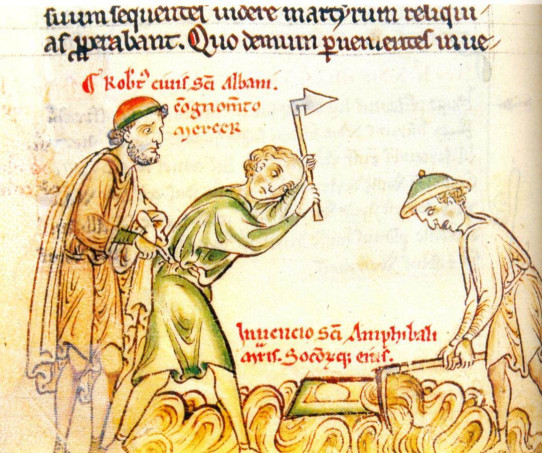
The FREE lecture will take place on Wednesday 27th January at 1pm and again will be on Teams Live Event. For those wishing to join as members of the audience (booking NOT required) this is your joining url:
If you have not used Teams before, do not worry, you do not need to have Teams on your computer, and this is how to ‘attend’: join about 5 to 10 minutes before the start time – see joining url above. To join Teams (as you would for Zoom) click on the link or paste in your web browser. Then on the screen click on ‘Open Microsoft Teams’ (centre, top in the little panel, not the buttons in the middle of the screen). Then to get you into the lecture as an attendee click ‘Join now’ (as you would for Zoom). There is NO waiting room unlike Zoom in terms of being let in by the host, you come in through your own actions. If you get stuck, contact the CCCU IT helpdesk at 01227 922626 (weekday office hours only)
In case you haven’t caught the blog before, these lectures are a joint venture between the Friends of Canterbury Cathedral, the Centre for Kent History and Heritage at CCCU, and the Canterbury Association of Medieval and Early Modern Studies (CAMEMS) with MEMS at Kent to showcase the work of postgraduates and post-doctoral students from the two universities in Canterbury.
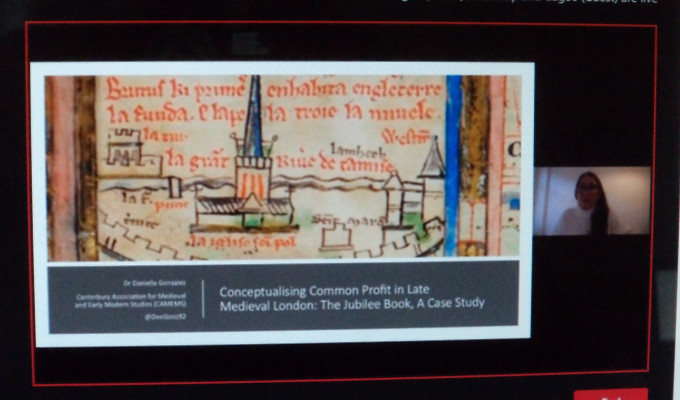
This week is again another surfeit of riches, which means a very short report on the FCAT lecture given by Nathalie Cohen before the meeting of the Lossenham Project history group and Dr Daniella Gonzalez’s Lunch Time Lecture. Nathalie kept her talk about what has been found on the inter-tidal zone of the Thames to medieval to present days finds – there is a very interesting project on shopping trolleys, for example. Working chronologically, Nathalie began with early medieval foreshore burials. Whether as a liminal location this represents a ritualistic element is feasible, as well as the link to punishment, something certainly known from documentary sources. Of course, there is also the possibility of accidents – falling out of boats, off quays etc, as well as murder. And in this context, all sorts of weapons have been found through to modern revolvers, while these foreshore burials come right the way through to the 18th century.
When it comes to objects presumably thrown into the river, large numbers of medieval tokens and pilgrim badges (including a very interesting non-Becket one, but I’ll say no more here because it is not my discovery, but I am mighty interested having published on this ‘cult’ from another perspective) have been recovered, the latter especially on the north bank – having crossed the river safely, perhaps. Other finds include numerous oyster shells with holes drilled in them, witches bottles, and moving into more recent times messages in bottles, crosses made of finds, and Hindu votive offerings – the Thames seen as a substitute for the River Ganges. Other religious artefacts recovered include a small statue of a Brazilian deity and another from Egypt. Such acts presumably demonstrate the continuing spiritual value placed on rivers and this ritual element had run throughout Nathalie’s fascinating lecture. And as a final point, Nathalie said please watch out for the tv programme at some point this year on what a group of archaeologists found in the River Stour in Canterbury last summer.
As readers may remember, Dr Andrew Richardson of Canterbury Archaeological Trust is leading the Lossenham Project, with Dr Helen Clarke as the lead for the history group. Back in December the group had a preliminary open workshop to introduce the (documentary) historians to prospective volunteers and anyone interested in this community project. In part the meeting this week was a follow up to that, to review progress and to set up the next of the group’s open workshops, which we decided will be on historic maps and associated sources, on Tuesday 23 February at 7pm on Zoom. It will be led by Helen and Dr Brendan Chester-Kadwell, a landscape historian, and others from the group will assist where it will be useful. Annie Partridge (CAT) is building up a register of interested people, so if you would like to know more, please email her at Annie.Partridge@canterburytrust.co.uk
Due to technical difficulties, Helen had not been able to attend the December workshop, so for the first part of this meeting the December speakers gave a brief summary of their short talks and any follow-up activities they had been doing. Ake Nilson spoke first, saying that what he was interested in doing was to raise some research questions that he felt are important. These fall into three main areas, although a fourth, the 11th-century font in the parish church might be sufficiently large to have its own project, rather than being part of a project on the origins of Newenden parish church. Both of these projects may take the team into the period straddling the Norman Conquest because one of the few suggestions about the font so far is that the stone came from the Sangatte area in northern France and that it is executed in the Tournai style, having carvings on three sides. This focus on the later Anglo-Saxon/early Norman may be equally significant for research projects on Castle Toll and the relationship between the settlements of Lossenham and Newenden that are very close together. For the former, this opens up research into Alfred the Great’s lost burh and was the fortification there burnt by the Vikings, while the latter will bring in early charters and Domesday Book to think about political and religious boundaries, lordship and settlement characterisation, and why was Newenden’s market mentioned in Domesday. Indeed, the location of such markets provoked quite a discussion and its position vis-à-vis the border was thought a fruitful line of inquiry.
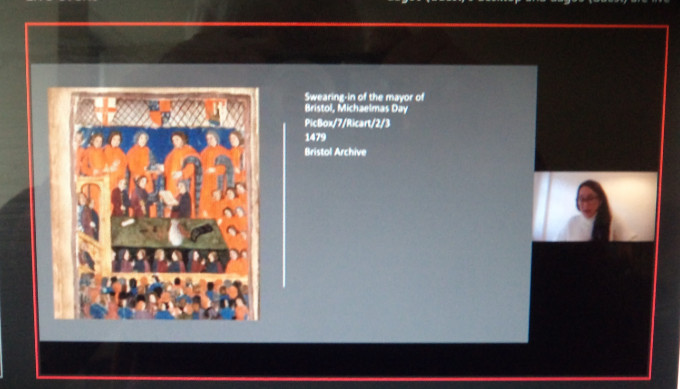
Brendan was next and he showed again the map of Wittersham Levels from 1633, produced as part of the contemporary discussion concerning diverting the River Rother to the south of Oxney. Such maps are valuable because they can help regarding land ownership and land users, the significance of absentee landlords, as well as land use. Moreover, for this area matters of drainage, reclamation and controlled (or uncontrolled) inundation are equally critical research topics. To this end Brendan showed a second, very faded map, but one if the project can get copied and redrawn may be crucial concerning features of the Rother Levels more widely because it covers a very large area, is very detailed and looks accurate in 17th-century terms. This, too, sparked considerable discussion, adding settlement patterns to the mix.
As Richard Copsey said, he has been providing Annie with material for the project newsletters and this has got him thinking again about the small community of Carmelite friars at Lossenham. Having studied medieval Carmelite friaries for many years from the documentary sources, he is hoping in this case archaeology will help to answer some of his questions. These include the size of the friary over time, the community’s relationship with its patron the Aucher family and the implications of this respecting their activities and the form of the friary church – was there an Aucher chantry chapel or similar? Also what was the relationship between the friars and those in the locality?
It is feasible that pre-Reformation wills for Newenden and surrounding parishes will, with archaeology, help to provide some answers. Having introduced wills to the workshop audience in December, I reprised my talk by saying that currently only PCC wills from The National Archives are available, but hopefully once we get into late spring it is possible the county archives will open up where there are the diocesan will registers. Even though it is a small collection for Newenden the surrounding parishes look more extensive and, as well as offering ideas on the parish church and the friary, these sources are often useful concerning family and neighbourhood, landholding and land use – putting people into the landscape. Much of this is for the future, but I am exceeding grateful to Jason Mazzocchi who is busy downloading PCC wills and indexing them for future study.
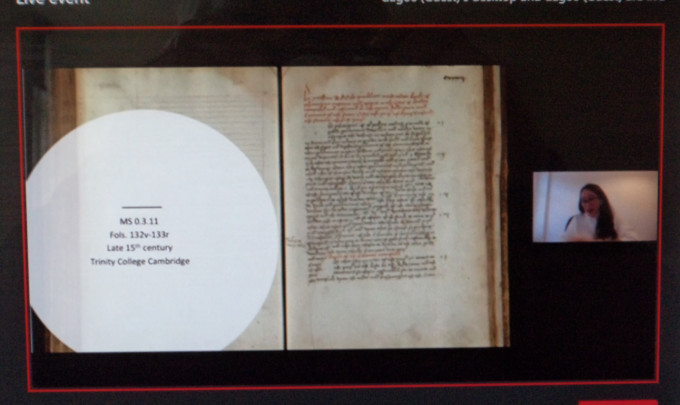
Martin Pexton has used wills in the past. He is very interested in the areas of social and landscape history and living locally has been undertaking his own research for many years. One factor he is interested in is the area’s manorial centres, which dovetails to a degree with Andrew’s research into the life and career of William of Cassingham, especially his activities during the First Barons’ War in the 1210s. Recently Andrew Richardson has been looking at two 18th-century estate surveys to try to find the manorial centre in Kensham, part of the parish of Rolvenden. This has proved fruitful, and even if he hasn’t identified the site of the manor, he has located a small area that he thinks would justify archaeological investigation, hopefully next summer. The group agreed this was a good idea, and such projects would seem to fit within the overall scope of the project that sees Lossenham as the centre of the web with lots of other projects radiating out and intersecting radially as well. Moreover, as Andrew was keen to point out, this 4-year plus project aims to provide ideas about the landscape of the Rother Levels, as well as enriching culturally, artistically and spiritually (very widely defined) the local community. Thus, coming back to the start of this report, the order of things is probably the next newsletter, the February workshop, and hopefully in April archaeologists out in the field.
I now want to turn to Dr Daniella Gonzalez lecture today which was especially fitting on the day that the new US president will be sworn in, hopefully espousing the idea of ‘common profit’. Whether he knows about the term and its history back to Ancient Rome, I have no idea, but as Dani said when she began her lecture, one way of thinking of the idea of common profit is to think of providing for the many rather than for the few – the community’s good over that of the individual, especially where it hurts the community. Now community, of course, may mean nation, but just as pertinent is the idea of the county, town or other grouping where there is a collective identity, a feeling of belonging.
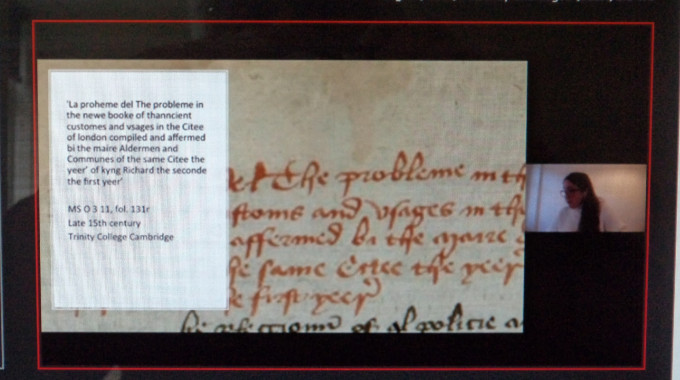
For her talk, Dani was looking at civic society, specifically late 14th-century London and the tumultuous period at the end of Edward III’s reign and the first decade of Richard II. For those not familiar with medieval history, think Chaucer and the Peasants’ Revolt. We are looking at a time when corruption was perceived as rife – remind you of anything – where those in power helped themselves and their friends to the detriment of the common good, the governed suffering accordingly. Those behind the ‘Good Parliament’ of 1376 wished to stop this, and among those in their sights were three prominent London aldermen. As can happen in history, the good guys don’t always come out on top and the ‘Bad Parliament’ the following year reversed the decisions. However, out of all this political carnage might be said to have come some good in that the commonalty (citizens) of London sought change, complaining to the mayor and aldermen that corrupt leading officials should be removed and replaced by worthy men; and that matters such as the making of new civic regulations should be done before all, not in secret.
Furthermore, there was the feeling abroad that civic officials were involved in a binding contract with the commons, they had a civic duty and responsibility, thereby bringing in moral overtones, to work for the city’s common profit. Of course, this could be demonstrated in various ways, but oath-taking was a sacred undertaking by the civic officers on their election or appointment, just as it was for the monarch at the coronation. And it is these oaths that were written up in the Jubilee Book, a self-conscious collection representing how towns, specifically London, should be governed.
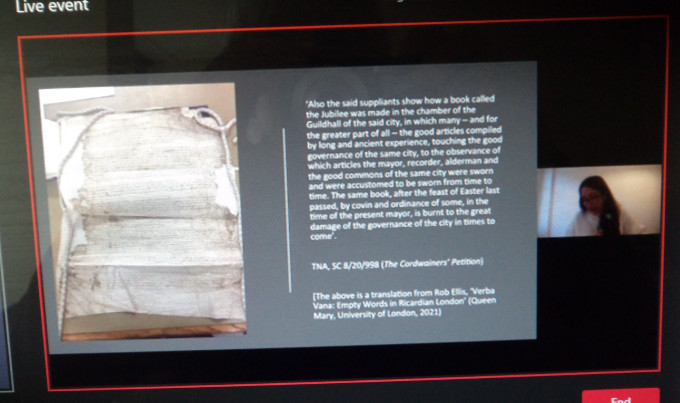
However, not everyone within certain sections of London society was quite that enthusiastic and, as Dani explained, the Jubilee Book was destroyed in March 1387 – it went up in flames. Not, of course, that all agreed, and as Dani showed certain London guilds, including the Mercers and the Cordwainers were prepared to petition against this, seeing the destruction as detrimental to the well-being of the city, and their members. But there is a copy, as discovered by Professor Caroline Barron the premier expert on medieval London, because the text, with other examples of civic administrative and similar documents, is now a Trinity College manuscript at Cambridge (such a text was something an alderman would have been interested in, or perhaps even a common clerk – compare Daniel Rough’s New Romney book, or a late 16th-century compilation, also of Romney material now in Canterbury Cathedral Archives and Libray). So Dani has copies of these oaths, and there are large numbers of them because they are specific to the different positions within London’s civic government. As she demonstrated, the wording of the specific oaths reflects the specific role of the civic officer(s) in terms of his/their duty to the commonalty, and the term common profit is widely used within these oaths. Thus, as Dani concluded, this investigation offers important ideas about the notion of true and good governance, social responsibility, and how this was articulated and to be performed by different sections of the London civic authorities, of importance to Londoners, but also to London’s relationship with the king.
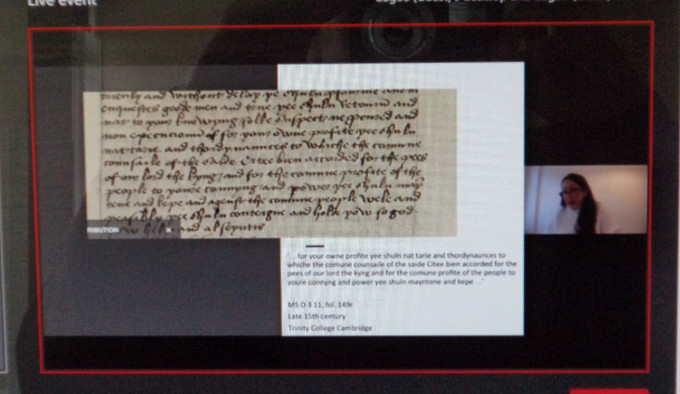
This fascinating lecture to an audience of about thirty people, generated several very interesting questions on such diverse topics as current parallels, the role of civic ritual, how far such ideas had apparently passed down through late 14th-century society, and whether we can see such ideas in the sermons of John Ball – see I can get the events of 1381 back in again!
So finally, my thanks to Dani for giving a great lecture, to Dr Diane Heath for again acting as the producer, to Toby Charlton-Taylor, our AV expert, who had also helped yesterday for the practice run, and to our audience for being there and asking such excellent questions. And next week we are on the trail of a saint’s ‘relics’ in the company of Lily Hawker-Yates, which promises to be an exciting investigation, please do join us.
 Centre for Kent History and Heritage
Centre for Kent History and Heritage Sheila Sweetinburgh
Sheila Sweetinburgh 1553
1553

